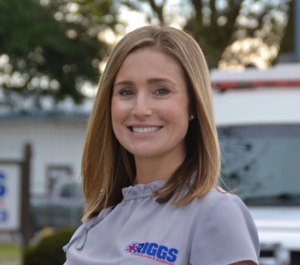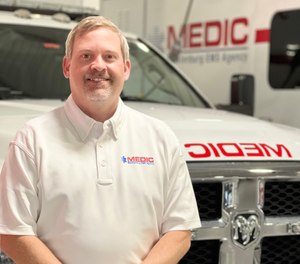Podcast | EMS One-Stop | Resuscitating EMS through trend analysis
43 min
Collecting and communicating the big EMS news of 2023
The American Ambulance Association and the Academy of Mobile Healthcare Integration (AIMHI) collect, collate, categorize and share weekly EMS-based news stories widely with many national organizations and associations, including NHTSA, USFA and NAEMT.
The information contained in the news tracker allows officials and EMS leaders to brief and educate journalists and elected officials, as well as the public as to the current plight of EMS. EMS is delivered on a local level and those experiencing issues with their service can believe it is just them suffering funding shortages, staffing challenges, hospital delays or general poor performance. The tracker can be used to demonstrate that the issues are occurring on a wider regional, state, national and, in some cases, international level.
In this episode of the EMS One-Stop podcast, host Rob Lawrence, who also heads up the AAA-AIMHI news collation effort, welcomes fellow news collator, Rodney Dyche of Patient Care EMS; and AIMHI Education Committee Chair, Matt Zavadsky, chief transformation officer at MedStar Mobile Healthcare. Rob, Rodney and Matt examine EMS news and current trends, and discuss how these themes can be used to inform, influence and educate.
Top quotes from this episode
“There’s a perverse ‘incentive’ about response time … if you have the target of 8:59, you arrive on time and the patient dies; that’s a success. If you arrive in 9:01 and the patient lives; that’s a failure. That’s absolute garbage” — Rob Lawrence
“There was a quote from Dr. Clawson in a news story that was done in Minneapolis, and I love his quote. He says, ‘there is no evidence that using red lights and sirens have saved more lives than they’ve taken.’” — Matt Zavadsky
“Every week in this great country, an ambulance is stolen either from hospital or from scene – that’s avoidable.” — Rob Lawrence
“Stop being timid. Stop licking your wounds. Get out in your community, talk to your elected officials. Talk to your city managers or county administrators – very factually, not emotionally. There will be time for emotions, but give them the facts and let them know what it’s gonna take to resuscitate their EMS delivery system.” — Matt Zavadsky
Episode contents
00:23 – Guest introduction
02:06 – AAA/AIMHI News Tracker and story categories
04:22 – A resource to brief the press and elected officials
04:30 – Operational challenges across many states
05:50 – Massive sign-on bonuses – robbing Peter to pay Paul
06:30 – Staffing and funding issues
08:40 – Communities/local governing bodies facing the fact that they are running out of money, and their EMS isn’t free
09:40 – Transitioning from a volunteer to a paid system
11:00 – Explaining EMS economics to your elected officials
11:50 – Has anyone died? Bring data
13:30 – EMS systems closing
15:30 – “Elected officials get nervous deciding to allocate funding to a service that they haven’t had to fund or haven’t, haven’t had to fund to this certain level in the past.”
18:40 – Response time
19:25 – Increase in low acuity calls
20:30 – Service design
22:50 – Single- versus double-paramedic crewed trucks
25:04 – MEDIC Charlotte – Taking bold steps within categories of response
27:00 – The rate of ambulance crashes across the county at intersections
27:47 – If you are not the ambulance driver … who is?
29:49 – There is no evidence that using red lights and siren have saved more lives than they’ve taken!
30:30 – Stolen ambulances
32:59 – Supply chain and vehicle availability
34:00 – Rurality and ambulance deserts
35:00 – Violence against providers
37:00 – Responding to patients in crisis/agitated patients
38:00 – How to use the media log in your locality to good effect
40:00 – Final thoughts
About our guests
Matt Zavadsky is the chief transformation officer at MedStar Mobile Healthcare, the exclusive emergency an
Limited options for professional growth and the lack of a clear career path are barriers to recruitment, retention and career longevity.
The EMS Burnout Repair Kit series, presented by EMS1 and Zoll, equips individuals at all levels in EMS with tools for dealing with the primary sources of burnout, helping them emerge as better, happier providers and more complete people.
In this installment, a panel comprised of individuals representing different career paths in EMS and leaders from progressive agencies will discuss resources for career advancement and resiliency, how to find the path that is right for you, and how agencies can support providers in advancing their careers.
Join the live discussion, March 1 at 1 p.m. CT
Carly Alley

Carly Alley is the executive director for Riggs Ambulance Service in Merced, California. Earlier in her career, Alley served as a firefighter-EMT in the U.S. Forest Service while earning her paramedic certification. After being hired by Riggs, she transitioned to the agency’s tactical EMS program, where she spent 10 years as the team leader before moving into administration.
Michael Fraley, BS, BA, NRP
-1.png?w=300&format=jpg&quality=87&crop=28%2C0%2C300%2C265)
Michael Fraley has over 25 years of experience in EMS in a wide range of roles, including flight paramedic, EMS coordinator, service director and educator. Fraley began his career in EMS while earning a bachelor’s degree at Texas A&M University. He also earned a BA in business administration from Lakeland College.
When not working as a paramedic or the coordinator of a regional trauma advisory council, Michael serves as a public safety diver and SCUBA instructor in northern Wisconsin.
John (JP) Peterson, MS, MBA

JP Peterson is the newly appointed executive director at Mecklenburg EMS Agency (MEDIC) in Charlotte, North Carolina. He started his career as an EMT in Chicago in 2000 and most recently served as vice president of Florida operations for PatientCare EMS Solutions.
He is licensed as a paramedic in Florida and North Carolina, and holds National Board Certification as an occupational therapist. He has completed Six Sigma Yellow Belt certification and is a graduate of the American Ambulance Association, Ambulance Service Manager Course. JP received the Pinellas County Commissioner, John Morroni Award for first responders in 2013.
JP is a past president of the Florida Ambulance Association. He is a member of the North Carolina Association of EMS Administrators as well as the AAA Bylaws, Professional Standards and Ethics committees.
The 2021 EMS Trend Report, produced in collaboration with Fitch & Associates and the National EMS Management Association, and sponsored by Pulsara, continues our effort to identify how those in EMS perceive growth, change and the challenges impacting the sustainability and future of the industry.
Last year, we said that 2020 would be a “defining year” for EMS. Even at the time, soon after the emergence of the new coronavirus in the U.S., we didn’t realize how much that might be true. It certainly was a defining year for EMS, for healthcare and for the entire global community.
A year later, the long-term impacts of the pandemic on our profession remain uncertain. What we do know is how the pandemic highlighted the adaptability of EMS. The sixth annual EMS Trend Report dives into the impact COVID-19 had, and didn’t have, the changes we’re embracing and the change providers want to see, as we explore the opinions, concerns and hopes of your colleagues across EMS at this critical moment in history.
Download your copy to read:
EMS1 Interview of AAA President Shawn Baird by AAA Communications Chair Rob Lawrence
As we enter, hopefully, a happier new year, several of our national associations that have been at the forefront of collaborative advocacy efforts and the voices of the EMS profession have undergone planned changes in their leadership.
To welcome in 2021, I sat down, via Zoom, with Shawn Baird, incoming president of the American Ambulance Association and asked him about 2020 and his thoughts on the future of our industry. Shawn is the vice president for rural services with MetroWest Ambulance Family of Companies in Oregon. Shawn spent the last two years serving the AAA as president elect and has been at the center of AAA activity and advocacy.
From Rob Lawrence’s EMS One Stop Podcast at EMS1
The American Ambulance Association HR Consultant discusses options open to EMS managers to ensure providers are vaccinated
The word of the week is vaccine, but is it giving EMS leaders a headache already? Host Rob Lawrence discusses the issues with American Ambulance Association HR Consultant, Scott Moore. Rob and Scott discuss the options open to managers to ensure all are vaccinated, while acknowledging the hope that science and understanding will prevail. They also discuss the other major news item of the week, EMS funding and the lack of it as reduced incomes put the very viability of service delivery at risk.
Scott Moore is a Massachusetts licensed attorney and possesses certifications as both a Professional in Human Resources (PHR) and the Society for Human Resources Management Certified Professional (SHRM-CP). He is a member of the American Bar Association (ABA), the Massachusetts Bar Association (MBA), the Northeast Human Resource Association (NEHRA), and the Society for Human Resource Management (SHRM).
In addition, Scott is an active member of the American Ambulance Association and has been a site reviewer for the Commission for the Accreditation of Ambulance Services (CAAS) for many years.
Read Rob’s article, “The word of the week is vaccine,” and listen to the podcast below.
From EMS1 on July 14 by AAA Communications Chair Rob Lawrence
Fifty years ago, on July 15, 1970, then California Governor Ronald Reagan signed into law the Wedworth-Townsend Paramedic Act. The law created the conditions for the establishment of the first accredited paramedic training program in the United States.
The story of American paramedicine did not begin in California or even in the U.S., but in Belfast, Northern Ireland. The inspiration for this program came from World War II era British Royal Army Medical Corps (RAMC) Medical Officer, Professor Frank Pantridge, MD.
On May 29’s Inside EMS podcast, AAA Communications Chair Rob Lawrence spoke with hosts Chris Cebollero and Kelly Grayson about national EMS issues including reimbursement, ET3, and more.
I recently reported on how the leaders of a few of our national associations united to tell the story of EMS on the front lines and to draw attention to the shortfalls we are all encountering daily from PPE to funding. EMS providers of all denominations are also coming together at a state level to tell their story and appeal for assistance and funding to ensure the continuity of operations. On Apr. 15, 2020, the Professional Ambulance Association of Wisconsin, Wisconsin EMS Association, Professional Fire Fighters of Wisconsin, and Wisconsin State Fire Chiefs Association conducted an online press conference to discuss the mobile healthcare situation in Wisconsin.
AAA Communications Chair Rob Lawrence shared his insights about recent EMS and fire association joint advocacy efforts in EMS1. Don’t miss the full article!
Last week, the AAA were approached, via EMS1, by U.S. News, a national publication represented by journalist Gaby Galvin, asking about COVID-19 as it affects the front lines, rates of infection and quarantine, and generally life on the street. This opportunity provided the chance to bring together three national organizations who are all working hard to represent their members, lobby Congress and highlight the challenges at the tip of the spear.